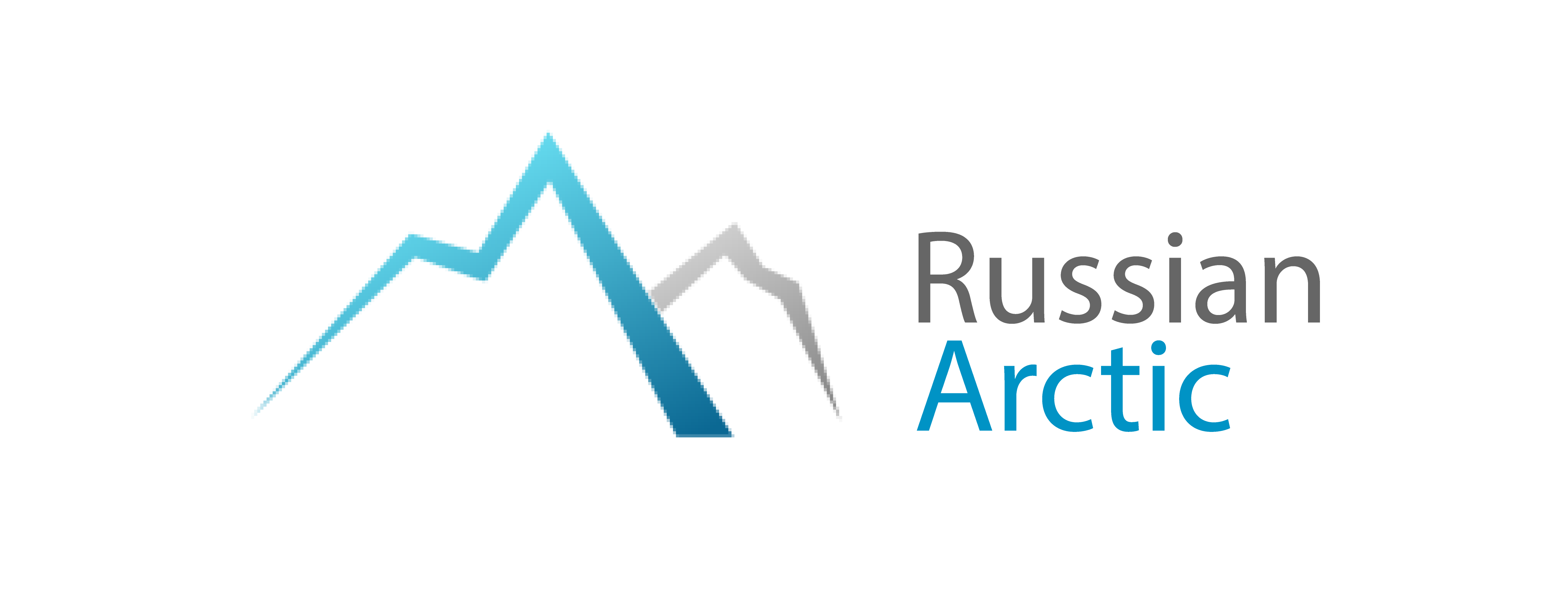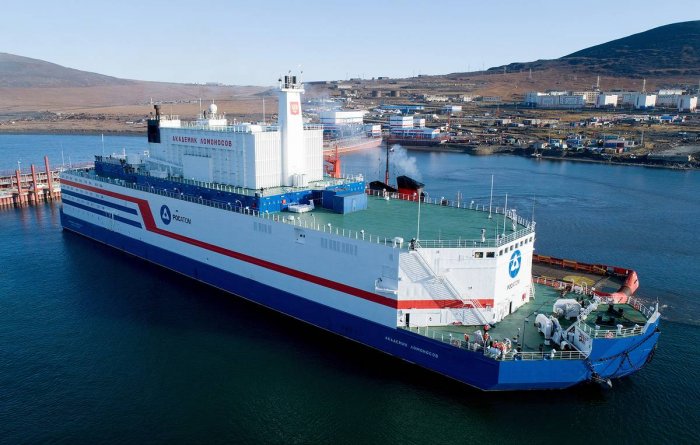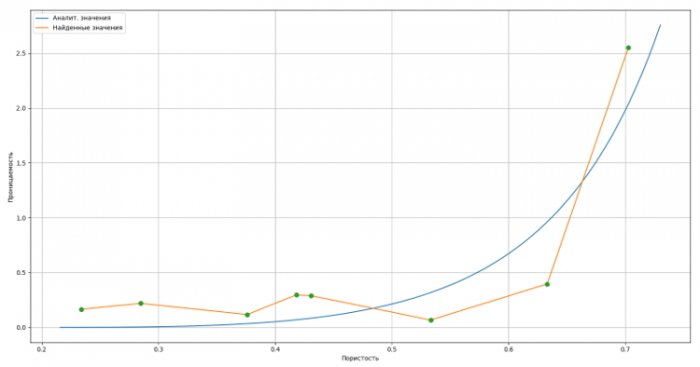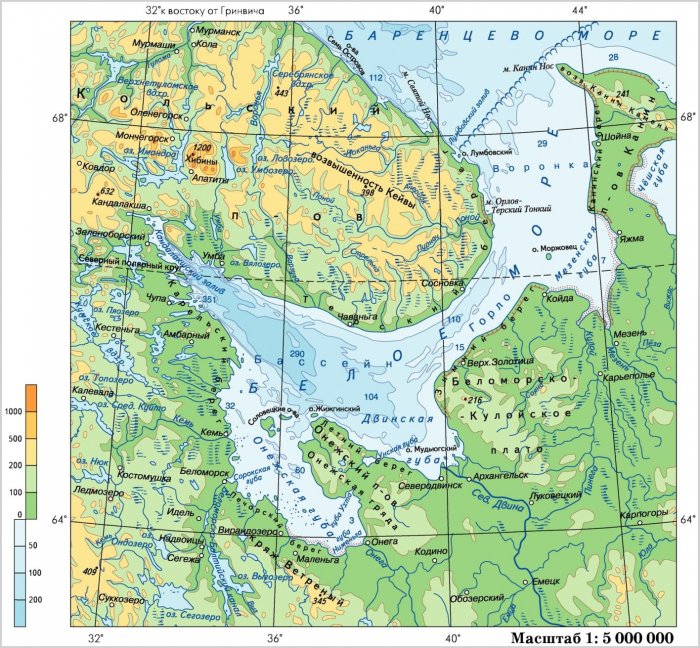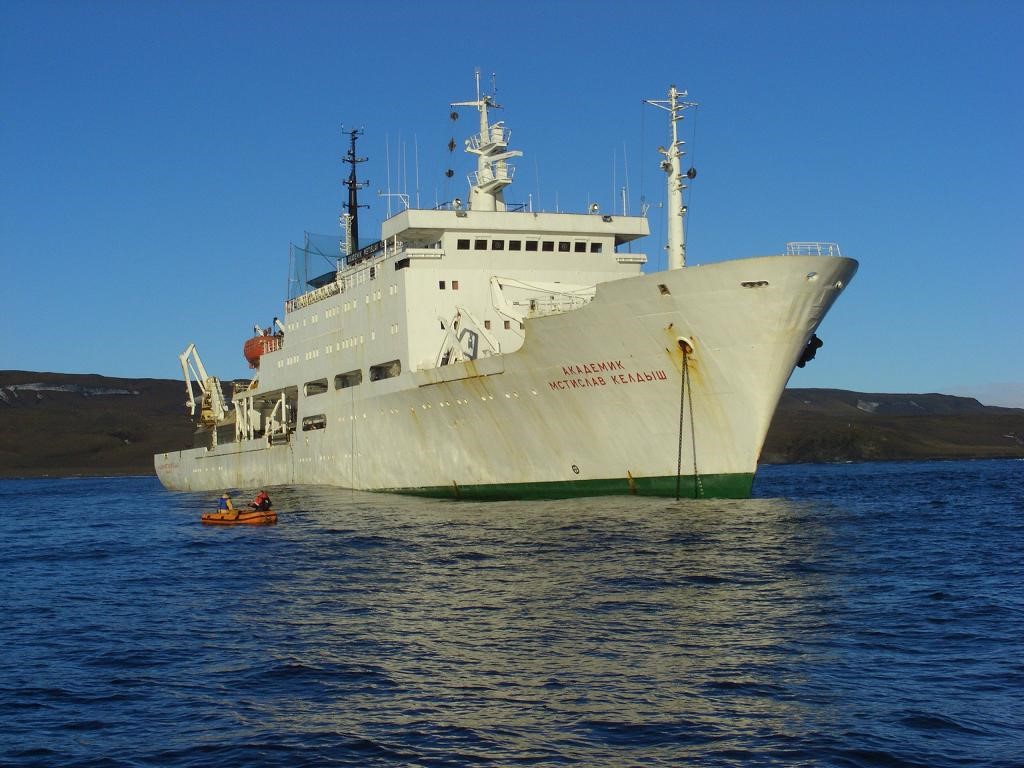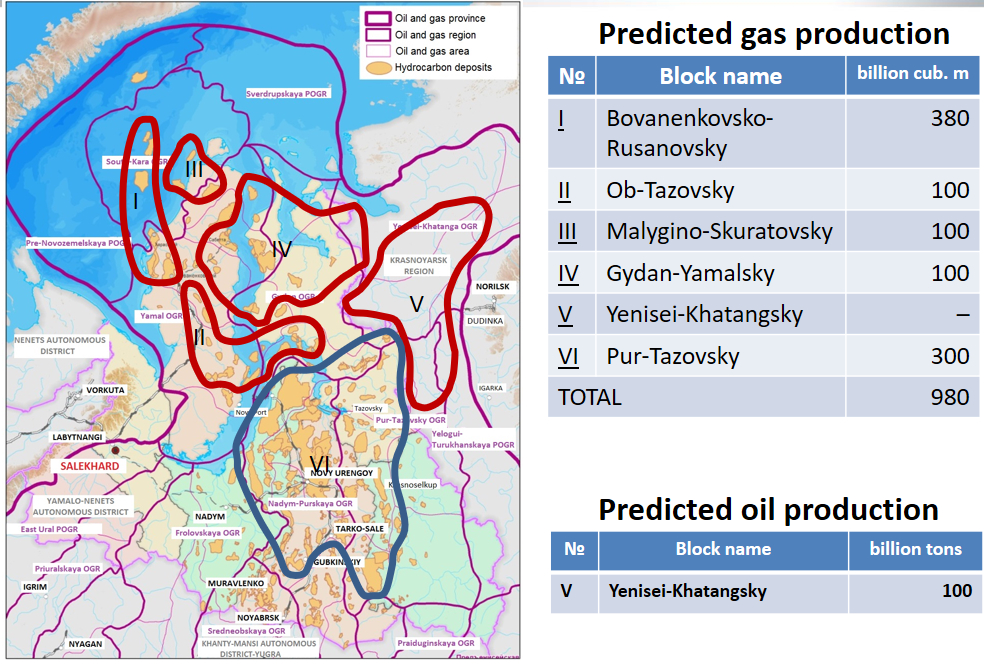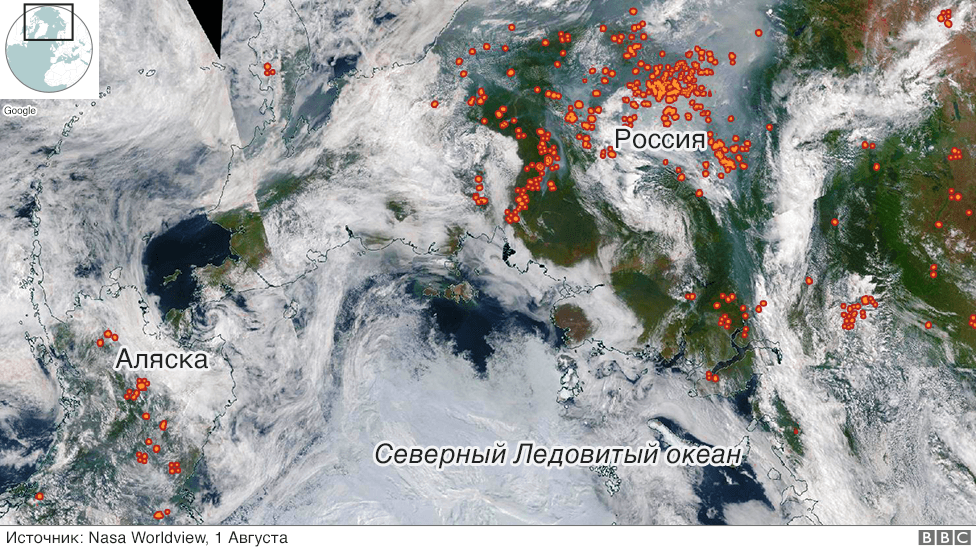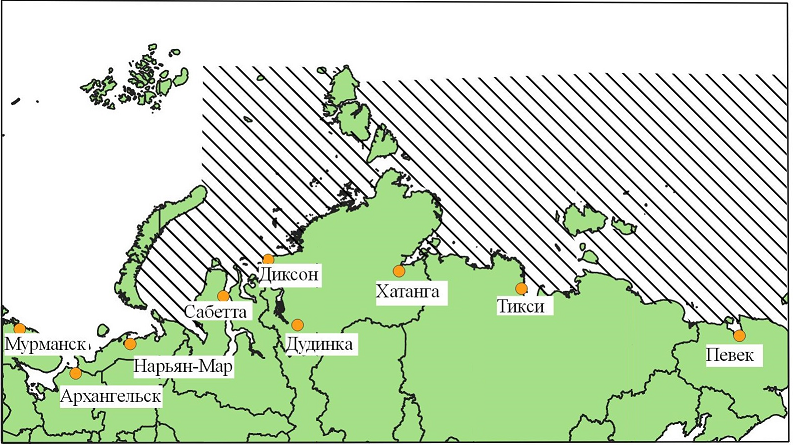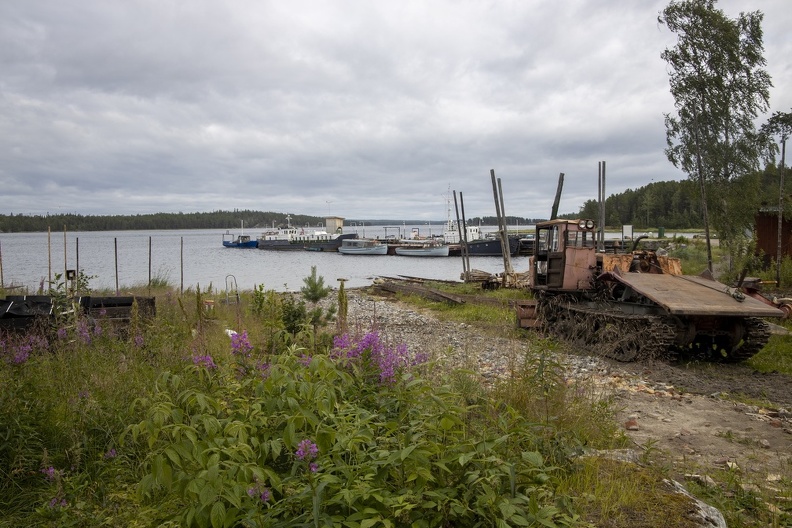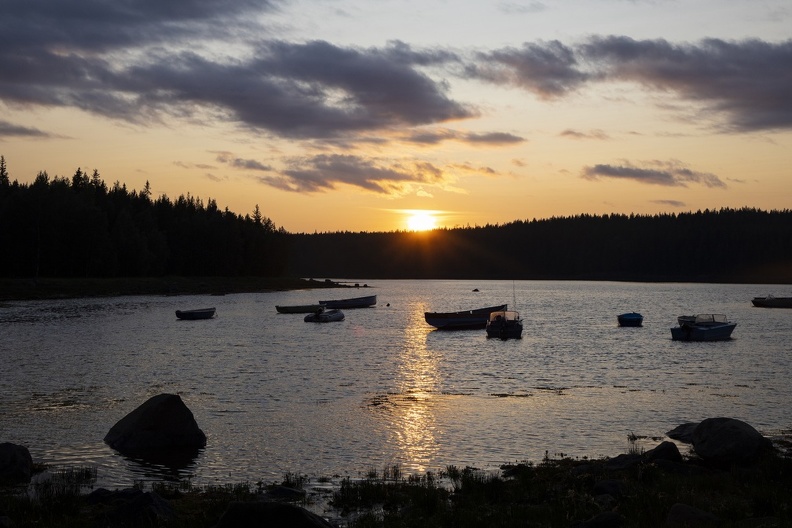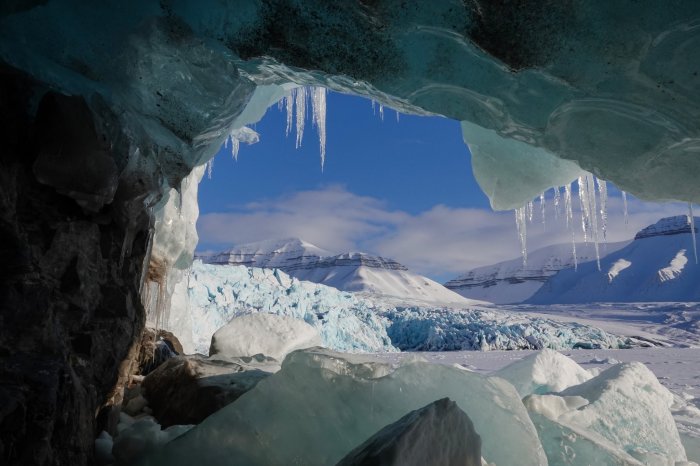The article is devoted to the analysis of environmental consequences of the impact on the environment of floating nuclear power plant, which is being built in Pevek, Chukotka Autonomous district. A brief technical description of the station is given, the history of the development of this project abroad and in Russia is considered. It is concluded that in the process of operation of floating nuclear thermal power plant of the territory and the water area included in its zone of influence, will experience radiation, thermal and mechanical effects, which will negatively affect the sensitive Arctic ecosystems.
Keywords: Floating nuclear power plant, floating power unit, nuclear energy, Arctic region, environment
Introduction
On the Russian arctic coast near the city of Pevek of the Chukotka Autonomous Region, a floating nuclear power plant (FNPP) is currently being built. Its purpose is to provide coastal civil areas and factories with energy and heat. After the FNPP is finished it will completely replace the Chaunskaya power station and the Bilibino nuclear power plant which have been operating since 1944 and 1974 respectively [1]. The construction of the onshore facilities started in Pevek in the fall of 2016.
The FNPP is a Russian collaborative project developed by the state-owned Atomic Energy Corporation Rosatom, the Baltic Shipyard Ltd., «Malaya Energetika» JSC, «Iceberg» Central Design Bureau and other organizations.
The FNPP structure includes a Floating Power Unit (FPU), hydrotechnical and onshore facilities. The basic element of the station is a flat-bottomed non-self-propelled vessel that houses heat and power generating equipment. The FPU is constructed separately at the shipyard and delivered to the location by sea in a finished form.
The FPU has a displacement 21.5 thousand tons. Its length - 140 m, width - 30 m, draught - 5.56 m, drop-side height - 10 m, superstructure height - about 30 m. The crew - 70 people, working three watches. The Crew includes administration, technical staff, security and coastal service.
The power unit houses two KLT-40S nuclear reactors which prototype are the reactors installed on the atomic icebreakers «Taimyr» and «Vaigach» and the lighter aboard ship «Sevmorput». Together these reactors are capable of providing up to 70 MW of electricity or 50 Gcal/h of heat. The body of the FPU also houses repositories of fresh and spent fuel and solid and liquid radioactive waste, an automatic control system, general ship systems, residential and office space [2]. There are no analogues of vessels fitted with such a large number of potentially dangerous equipment and materials.
The commissioning of hydrotechnical structures and coastal infrastructure in the area of Pevek is scheduled on August 2019. The FNPP will become operational in December 2019.
The construction of the FPU «Akademik Lomonosov» began at JSC «Sevmash» in the city of Severodvinsk on April 15, 2007. In 2008, the FPU project was transferred to the Baltic Shipyard Ltd. in St. Petersburg.
The FNPP project implementation was accompanied by series of legal proceedings, bankruptcies, disputes of right owners and regular delays. Today, the project is behind its own schedule for a decade, its budget is exceeded by millions of dollars. However, the project is moving towards its completion [3].
At the end of April 2018 the FPU «Akademik Lomonosov» was towed to the city of Murmansk, where in the fall of 2018 the reactor will be loaded with nuclear fuel and put into operation. In June-July 2019, the FPU will be transported to the work site via the Northern Sea Route and connected to the coastal infrastructure at the port of Pevek. Rosenergoatom believes that transportation will be possible without the intervention of icebreakers [4].
According to Rosatom, the FNPP is a new generation energy provider being constructed on the base of Russian nuclear shipbuilding technologies. It will be a reliable year-round energy supplier for industrial and civil facilities as well as infrastructure in remote regions of the Arctic and the Russian Far East, the country's fuel-deficient and extremely harsh climate regions [5].
Key project objectives are:
- total restructuring of energy production on the basis of floating nuclear power plants;
- rapid and sustainable industrial and socio-economic development of remote areas of the Arctic and the Far East - regions of Russia's strategic interests.
Floating power plants will allow to:
1. Renounce the importation of fossil fuels.
2. Create conditions for the development of industrial and infrastructural projects.
3. Boost exploitation of mineral deposits, including those on the shelf of the Arctic and Far Eastern seas.
4. Improve the living conditions of the population.
Rosatom is also considering the possibility of concluding contracts for the supply of floating nuclear power plants to a number of countries, such as the Republic of Cape Verde, China, Indonesia, India, Brazil, etc. The interest of the developing countries to the FNPP is due to its option to desalinate the seawater. One FNPP unit can produce from 40 to 240 thousand cubic meters of fresh water per day.
History of the FNPP construction
Richard Eckert, vice president of Public Service Electric & Gas, introduced the original idea of commercial use of floating nuclear power plants in 1969 in the US. In 1970, in attempt to put this idea to practice, Westinghouse and Newport News shipyard created the company Offshore Power Systems. They planned to build eight 1-1.2 thousand MW floating power plants for Public Service Electric & Gas and deploy them off the coast of the United States [6]. The next idea was to build artificial islands with two similar power units. The project, however, failed primarily due to financial problems at the Public Service Electric & Gas and incorrect marketing: they planned to supply floating nuclear power plants to heavily populated northeastern US states, where was no need in extra electricity production. In addition, the incident at the nuclear power plant «Three Mile Island» (March 28, 1979) had a very negative impact and literally stopped the development of nuclear power engineering in the United States. As a result, both orders (Atlantic 1 and Atlantic 2) were canceled and Westinghouse had to stop working on the project after investing in it $180 million.
Nonetheless, the United States became the first country to use a floating nuclear power unit. It was a mobile nuclear power plant operated in the Panama Canal area from 1968 to 1975. 10 MW light-water reactor was housed on a transport vessel Sturgis (type Liberty). Today this station is the only FNPP in the world that was in practical operation. However, the system wasn’t perfect: it had extremely expensive maintenance and high demands to personnel (due to its «non-seriality») [7, 8].
In the USSR, the idea of using low-power nuclear power plants for electricity and heat supply of remote regions of the Far North and the Far East arose at dawn of domestic nuclear industry. The first example of a low power nuclear plant in the USSR was the 48 MW Bilibino NPP. It was built in 1974 in the village of Bilibino, in the permafrost, to provide energy to the developing mining industry in the Chaun-Bilibinsky district of the Chukotka Autonomous Region [9].
In the 1980s the series of large-scale feasibility studies in areas of the Russian North identified more than 80 locations suitable for the placement of small nuclear power plants. After more detailed studies, the number of potential sites was reduced to thirty-three, and they were submitted for approval to the USSR Council of Ministers. The Chernobyl accident on April 26, 1986 interrupted this process and postponed the development of low-power nuclear units in Russia for many years [10].
Today the need to develop remote regions with high economic potential brings back the idea of low-power nuclear plants in Russia. The increasing geopolitical influence and strengthening of the national security of Russia in the Arctic also contributes to this. One of the means of bringing the nuclear energy to these areas is the use of FNPPs.
One of the main arguments of Rosatom in favor of using nuclear power plants in these areas is higher economic efficiency compared to alternative power supply options. Diesel-fueled power plants – the primary source of energy in the remote regions – produce very expensive electricity primarily due to the difficulties of fuel delivery. Local prices of electricity exceeds those in the European part of Russia 10 or more times. That makes the placement of nuclear power facilities in remote regions very relevant. Low-power nuclear units will allow to replace the diesel-fueled power plants and significantly reduce the cost of electricity and heat [11].
Environmental and climactic conditions of the FNPP operation
Pevek is the northernmost city of Russia. It stands on the east coast of the strait of the same name, which connects the Chaun Bay and the East Siberian Sea, opposite the Routan Islands, in 640 km from Anadyr. The city is located beyond the Arctic Circle and belongs to the region of the marine climate of the Arctic zone [12]. This area is distinguished by long, frosty winters and a short (2-3 months) summers with low temperatures and frequent frosts even in the warmest periods (July - early August). The average annual temperature of Pevek is -10.4 °C. The transition of the average daily temperatures to positive figures usually occurs in the first decade of June. The average temperatures of the warmest month (July) do not exceed 7-8 °С in the Pevek region. In September, average daily temperatures become negative again. The coldest month with average temperatures of -22-32 °С is January, less often - February. The polar night lasts from November 27 to January 16 [13].
From the north, the Chaun region is washed by the East Siberian Sea (the Arctic Ocean basin). The distinguishing features of the northern seas of the Chukotka region are difficult ice conditions, storms, fogs, and strong flood currents. Most of the year the East Siberian Sea is covered with ice. Floating ice often remains near the coast, even in summer. The largest river of the Chaun region is the Chaun. It flows along the lowland of the same name into the Chaun Bay. The river length is 350 km. After spring floods the Chaun changes the direction of its riverbed [14].
The arctic tundra of the Chaun region is characterized by a poor supply of organic life and an extremely low increment of phytomass. Therefore, the vegetation cover is rare even in the flat areas and the spots of gravelly loam occupy large zones of the land. Permafrost soils, icing, etc. are highly common.
Periodically Pevek comes under the power of Yuzhak - a very strong gusty dry southern wind that falls on the city from the coastal hills. Before Yuzhak emerges, light cumulus clouds appear above the mountain peaks. The wind starts blowing abruptly, accompanied by snow whirls, with a sharp drop in atmospheric pressure. Within one hour, the wind speed can reach 40 m/s with gusts up to 60–80 m/s [15]. Yuzhak lasts from several days to two weeks. The city of Pevek was designed to confront this threat. The houses were built so that each city district had a shield building, blocking a strong airflow and protecting other constructions.
The FNPP occupies the coastal water area and part of the coast. The geological structure of the Pevek coastal area consists of permafrost soils containing ice within. Due to uneven distribution of the ground ice, the permafrost soils are extremely heterogeneous and variable. The permafrost zone has almost consistent distribution on land. Under the bottom of the seas, frozen soils are covered under fast ice, in the remaining areas they are preserved by small islands [16, 17].
Environmental and climactic conditions of the area around the city of Pevek are undoubtedly of paramount importance for ensuring the ecological safety of the FNPP operation in the region.
The FNPP impact on the environment
The first thing that troubles ecologists is the possible radiation effect from the FNPP caused by its usual operation as well as by miscalculations in the design or possible accidents, including when towing the FNPP to the operational area.
The FNPP constructors claim that their project fully complies with the requirements of the modern regulatory framework in terms of ensuring the safety of nuclear power plants and vessels with nuclear power reactors.
Preliminary expert estimates of the possible radiation impact of the FNPP on the environment revealed the following results.
In accordance with the requirements of the SR NPP-2003 [18], the power of γ-radiation on the exterior surface of the FPU will not exceed:
- on the surface of open deck in the zone of controlled access - 0.2 µSv/h;
- on the surface of open deck in the free mode zone - 0.1 µSv/h;
- on the board above the waterline - 0.2 µSv/h;
- on the board below the waterline and at the bottom - 2 µSv/h.
The maximum daily emission of the FPU ventilation system in normal operations of the reactor will be 0.01 mCi/day of argon-41.
The estimates of the average annual concentrations of argon-41 in in the surface layer of the atmosphere show that the maximum figures will be reached at a distance of 200-300 m from the FPU and will be about 1.2x10-2 Bq/m3 [19].
According to calculations, γ-radiation doses from the ejection cloud at a distance of 200-500 m from the FPU will not exceed 20mSv and will decrease more than 10 times at a distance of 2-3 km.
Considering all obtained data, the possible radiation level hike in the intended FNPP operational area will be 0.002% of the natural dose there.
In the scenario of an accident with the worst radiological consequences the radiation exposure is determined by [20]:
- external γ-irradiation of the body due to the presence of radioactive products in the surface layer of air;
- external γ-irradiation due to exposure to radionuclides accumulated in the surface layer of the soil;
- internal irradiation of organs and tissues due to inhalation of radionuclides in the human body;
- internal irradiation of organs and tissues due to oral intake of radionuclides into the human body with contaminated food products of local production.
The biggest contributor into the organism irradiation is the γ-radiation of the radionuclides contained in the emission cloud (48-55%). On the second place is the irradiation due to radionuclides fallen on the terrain (from 23 to 28%). The third and fourth place is taken by the irradiation dose from inhalation of radioactive substances (6-16%) and from the intake of radionuclides with local food products (8-12%).
Analysis of γ-radiation from the emission cloud indicates that main sources of radioactive contamination will be Xenon-133, Xenon-135 and Krypton-85. Iodine-133 and Iodine-131 will contribute to the contamination in the form of radioactive fallout. Cesium-137 share in the contamination will be about 10%.
The conservative estimate of the radiation exposure in case of an accidental release reveals that the maximum concentrations of nuclides in the surface layer of the atmosphere will be a fraction of a percent of the tolerable level of contamination. Cesium-137 soil contamination will not exceed 5 MBq/km2 and will not increase the background radiation level.
The irradiation of the population living in the area of the possible accident will be about 0.002% of annual atmospheric peak dose and about 0.05% of the soil background radiation level [21].
Preliminary conservative estimates data leads to the conclusion that the possible accident on the FPU does not go beyond the scope of the “incident” on the IAEA scale. According to international recommendations and national requirements, this class of accidents does not require conducting special protective procedures for the population and outside the territory of the source of radiation [19]. This circumstance makes it possible to limit the sanitary protection zone to the territory of the FNPP site with the water area at the FPU parking site.
Considering the above, we can make a preliminary conclusion that the radiative effect of the FNPP on a population is limited to its site, and even in case of accidents, including beyond design-basis accidents, no emergency measures to protect the population will be required.
The following malfunctions are considered as the initiating event for the beyond design-basis accidents [22]:
- cross section rupture of the coolant supply pipe;
- cross section rupture of the steam collector of the steam generator;
- rupture of the I-III circuits of the heat exchanger tube.
The automation failure of the localization valves is considered as the independent initial event.
In the worst scenario of a beyond design-basis accident γ-radiation doses will not exceed 0.5 mSv, which is far below the maximum tolerable radiation dose of 5 mSv.
The effective radiation dose of critical groups of the population from the radiation exposure will not exceed 0.15 mSv at all distances from the FPU.
In the event of an accident at the FNPP the ecological harm will be determined primarily by the volume of long-live radionuclides fallout [23].
In case of design-basis accident the maximum possible release of radionuclides with long half-life (Cesium-134, Cesium-137) into the atmosphere will be about 2×107 Bq. In this scenario, the radioactive contamination of the soil can reach 1.2 Bq/m2 at a distance of 1 km from the FPU and 0.3 Bq/m2 at a distance of 2 km. These figures are much lower than the tolerable level the background territory contamination with cesium-137 due to global exposure [19].
During the first year after the design-basis accident, the γ-radiation dose rate may increase by 6×10–4 μSv/h that is 1% of the background level.
In case of a beyond design-basis accident, the long-lived radionuclides fallout can be 0.4 GBq.
At a distance of 1 km from the source, soil contamination with cesium radionuclides can reach 24 Bq/m2. As the distance from the accidental release point increases, the level of contamination will decrease substantially and at a distance of 5 km from the source will be 0.12 Bq/m2.
As the data above shows, the radiation impact on the population and the environment during normal operation and in case of any accidents, including beyond design-basis, does not exceed the level of natural radiation level, which allows to provide high level of safety and environmental friendliness in the operational area and site the FNPP closer to consumers.
According to the calculations of the project developers, the total emission of inert radioactive gases (IRG) into the atmosphere from one reactor will not exceed 10 Ci [2]. However, emissions of such IRG like Krypton-85 (half-life is 10.7 years) are far from harmless. In nature, small amounts of Krypton-85 is generated by the interaction of cosmic rays with stable Krypton-84. In the “preatomic era” krypton-85 content in the atmosphere was really small [24].
In terms of the scale of emissions, Krypton-85 takes the first place among other radionuclides emitted by nuclear power plants: its volume in atmosphere is bigger than all other radionuclides [24].
Krypton-85 is very mobile and hard to filter. It is not absorbed by the World Ocean or the soils, but easily penetrates some tissues of living organisms, for example, the adrenal cortex, the fatty tissues of humans and animals. It is known that even small doses of krypton-85 radiation can increase the risk of skin cancer. Krypton-85 affects the course of biological processes by blocking the electrical conductivity of tissues. [25].
A high concentration of krypton-85 in the atmosphere leads to extremely unpleasant consequences. Krypton-85 changes the electrical conductivity of the atmosphere which provokes major changes in the Earth geophysics, for example, a decrease in the electrical charge of the Earth, a change in the magnetic field, a decrease in the electrical resistance of the atmosphere between the oceans and the ionosphere, an increase in thunderstorms, a change in the structure of precipitation, and an increase in the number of storms and tornadoes [26, 27].
Moreover, it is worth considering that in the atmosphere Krypton-85 acts like a greenhouse gas, thereby contributing to the anthropogenic climate change on the Earth. Later the problem of Krypton-85 emission could be no less important than the problem of depletion of the ozone layer.
Can the IRG emissions from the FNPP become the catalyst to irreversible changes in the “world weather kitchen” as they call the Arctic sometimes? Especially considering the fact that these changes may affect the climatic characteristics of not only the Arctic, but also other regions of the planet. The impact of the FNPP operation on the radiation level in the Arctic requires a separate analysis.
The radioactive safety of the Arctic is also essential because due to anthropogenic climate change, the latitudinal circulation of air masses is increasing. Cold air masses from the Arctic regularly spread thousands of kilometers to the south of the coast of the Arctic Ocean (in Northern Eurasia, cold Arctic air masses can reach 50º N) and radioactive clouds can flow with them [15].
A high contagious effect presented by a radioisotope Iodine-131 should be taken into account. Despite the fact that the half-life of Iodine-131 is only 8 days, nevertheless, it is the main dose-forming isotope during the first days after the radiation accident. Short-lived isotopes were the primary reason for thousands of cases of thyroid cancer in areas affected by the Chernobyl disaster [28].
The long-term analysis of the possible impact of radioactive releases from FNPPs should include mandatory studies of the migration of radionuclides along food chains and the phenomena of bioaccumulation of long-lived radionuclides.
Because of climactic features of the Arctic region where the winter lasts up to 9 months, radioactive emissions will be partially deposited in the snow cover along the wind rose. During the period of turbulent Arctic spring, the radionuclides accumulated in the snow cover will continue spread increasing the contamination area.
It was established that people living in the northern territories received significant doses of internal irradiation due to bioaccumulation effect in the food chain lichen-deer-man [29]. This was discovered after a mass test of nuclear weapons in Novaya Zemlya. Due to the long half-life of Cesium-137 (30 years) it is intensively accumulated in lichen which is the staple food of reindeer. Entering the body of deer, Cesium-137 is stored up mainly in the muscle mass, and then goes along the food chain to humans.
In addition, the agricultural enterprise «Chaunskoye» has been operating in the Chaunsky District since 2004. Its primary occupation is reindeer herding and fishing. At the time of its establishment, the deer herd comprised 14,148 head of cattle. Every year until 2008, the «Chaunskoye» enterprise systematically increased the reindeer head. The planned slaughter of deer in 2008 provided the entire region with meat products [30]. In this regard, it is necessary to conduct a thorough radiation monitoring of the territories that will be in the impact zone of the FNPP operation.
The expert community is also deeply concerned about radioactive waste (RW) and spent nuclear fuel (SNF) management on the FPU. There are special service in coastal infrastructure for atomic icebreaking vessels, but the FNPP project includes only stockpiling of RW and SNF at the FPU. This means that the FNPP is completely autonomous and will resolve all regular and emergency situations with RW and SNF on its own. In case of an accident, it will be quite difficult to call for rescue unit due to the remoteness of the FNPP and hard climate conditions usually presented in the region.
The towing of the FPU is another threat to the nuclear safety. The estimated lifetime of the FPU is 36-40 years. Every 12 years the FPU will be towed to the factory for maintains and repairs. During the factory repair, the fuel in the reactors will be reloaded and RW will be removed. This procedure will take 1 year, after which the FPU is put into operation again.
Since RW and SNF will be stockpiled at the FPU, the station will be towed to its destination with these nuclear hazardous materials on board. The risk of an emergency can be increased by the difficult climatic and weather conditions of the Northern Sea Route (the FPU needs to travel a distance of six thousand kilometers from Pevek to the Federal State Unitary Enterprise Atomflot site in the city of Murmansk). The sailing through the Vilkitsky Strait, the Laptev Sea and the East Siberian Sea promise to be especially problematic [15].
Naval and structural characteristics of the vessel ensuring the survivability and unsinkability of a floating object are of great importance for the FPU safety. The FPU design did not initially meet the high seaworthy standards. Flat bottom, huge sail area, low controllability due to the lack of own steering devices and engines automatically assigned the FPU to potentially dangerous (high level of danger) marine objects, which, according to the requirements, should always be accompanied by special towing vessels and facilities, even in the dock [2, 10, 31].
Unfortunately, the Russian Navy lost one nuclear powered submarine (NPS) during the towing procedure. K-159 - Soviet submarine of 627A «Kit» project drowned on August 30, 2003 near Kildin Island at a depth of 238 meters while being towed from Gremikha Bay for disposal at the Nerpa ship repair plant in Snezhnogorsk. 9 people died [32].
The concern of ecologists and public environmental organizations with the anticipated mass commissioning of the FNPP in the Arctic region is quite understandable. For many years, the territory and water area of this region have been exposed to a significant radiation. The history of radioactive contamination of the Arctic ecosystems includes 5 periods [33]:
1. The end of the 1940s-the 1990s – the influx of radioactive isotopes from the Ural and South Siberian factories to the Kara Sea via Western Siberian rivers;
2. The mid 1950s-early 1960s – intensive nuclear tests at Novaya Zemlya;
3. The mid 1970s-early 1980s – the discharge of radioactive waste from Sellafield’s plants and French coastal plants into the Irish Sea and the English Channel.
4. From 1986 to the present day – the release of radionuclides after the accident at the Chernobyl nuclear power plant;
5. The 1950s-1990s – periodic discharges of liquid radioactive waste, disposal of containers with solid radioactive waste, flooding of nuclear reactors and accidents on nuclear powered submarines.
The radioactive threat always drives high attention of experts and public but the thermal impact of the FNPP on the environment is worth considering as well. It is usually forgotten that the thermal effect of nuclear power plants exploitation influences the environment the most.
Thermal pollution of the environment from nuclear power plants with water-cooled reactors is about 1.5 times higher than that of thermal power plants of the same capacity [34]. This is due to the low efficiency level of nuclear power plants - no more than 35%. Two thirds of the heat produced by the atomic reactor is release into the environment. Calculations show that an average nuclear power plant heat flux reaches 1000-10,000 W/m2, which is similar to the heat flow from forest fires, volcanic eruptions and fires at oil rigs [26].
To cool the steam turbine the FNPP will consume a large amount of seawater (about 5,400 m3/h), which will then be discharged back [2]. The temperature of the discharged water will be 23-27 °C, while the temperature of the water in the area of the FPU operation in winter is -1.9 °C [35]. The water from the FPU will form a lens of warm waters, which means an ecological catastrophe for the entire local biocenosis - fish, invertebrates, plants and microorganisms.
Under the influence of a thermal field, thawing of frozen soils will occur. Their structure will be changed losing its strength characteristics. A number of cryogenic events will accompany the process of thawing: thermokarst surface subsidence, thermal erosion, rapid solifluction, etc. [36]. This will change the chemical composition of the water and produce liquids highly aggressive for metals and concrete.
Alongshore currents can transfer the heat from the FNPP on considerable distances and affect the frozen soils in other coastal areas.
For the most part the thermal and geological conditions of the areas under development are highly sensitive to external technogenic impacts. During the construction or other types of activity in the region, even seemingly insignificant man-made effects, such as removing vegetation, changing the thickness of snow cover in winter or the color of the surface, lead to shifts in the soil structure [37, 38].
In addition, the discharge of large volumes of water will create artificial flows that can affect the seabed, cause the sediment re-suspension and as a result obstruct the performance of the FPU.
The other examples of the FNPP thermal impact on the environment of the Arctic are:
- the formation of permanent fogs;
- the change of insolation;
- the change in the nature of precipitation;
- additional icing of buildings and structures.
Thousands of tons of heated water will be continuously discharged from the FNPP. It is obvious that during 8-9 months period of low temperatures, permanent fogs will be formed around the FNPP. The fog will negatively affect the health of people living in the neighborhood and the operation of the FPU iself. This will entail the change of insolation, the nature of precipitation, etc.
The eastern and southern coast of the Chaun Bay are the natural area for nesting, resting and molting places of several species of water birds (Black-throated Loon, three species of Eiders, Tundra Swan, White Goose, White-fronted Goose, Ross's Gull) [39]. These areas are parts of the State Reserve «Chaun Bay». The FNPP operation can impact the unique ecosystem of these zones as well.
Moreover, signs of anthropogenic eutrophication in the northeastern part of Chaun Bay are currently appearing [40]. Together with the thermal impact of the FNPP, the eutrophication could have a devastating effect on the ecosystem of the Chaun Bay.
The FNPP developers claim that the technical solutions incorporated into their project guarantee the complete seismic protection and high resistance of the FPU to external influences:
- earthquakes of 7-8 points on the MSK-64 scale;
- wind load corresponding to the maximum wind speed - 45 m / s;
- the hit from the fallen aircraft with a mass over 11 tons;
- extreme snowfall;
- lightning strike;
- the explosion of an external source with an overpressure of 19.5 kPa;
- explosion of a tanker with a fuel carrying capacity of 600 tons.
However, in recent years, due to changes in the Earth’s climate, the frequency and intensity of extreme weather conditions have increased, which may adversely affect the operation of the FNPP and lead to emergencies.
Conclusion
The FNPP in the city of Pevek will become the first floating nuclear power plant in Russia. It is the most dangerous floating nuclear facility among the existing that will be operated the hardest climactic conditions of the Arctic.
The territory and water area included in the FNPP operational zone will experience radiation, thermal and mechanical impact, which will adversely affect the sensitive Arctic ecosystems.
Last century nuclear arms race has already damaged the Arctic environment in the form of radioactive contamination, potentially dangerous submerged nuclear facilities, radioactive waste and drowned nuclear submarines. Additional radiation exposure from the FNPP is highly undesirable.
A number of experts believe that the FNPP is economically unprofitable [7, 31, 41] and alternative and renewable sources should be used instead: wind power and geothermal energy. In addition, gas reserves on the shelf create the possibility of using it as an energy source.
Obviously, for Rosatom this project is a possibility to test new technologies in the remote Arctic areas and develop new business strategies.
Also, one should not underestimate the threat of seizure of the FPU by pirates or terrorists aiming to commit an environmental terrorist attack, nuclear blackmail or other illegal acts. In the case of commercial success of the project, the FNPP will spread around the world, which will increase the threat of terrorist attack. Providing the secure environment for the FNPP operation will require unified international measures.
References:
1. http://www.rosatom.ru/journalist/interview/vitaliy-trutnev-chukotka-zhdet-pervuyu-v-mire-plavuchuyu-....
2. Technical design of a floating power unit with a KLT-40S reactor installation, project 20870, OJSC Iceberg Central Design Bureau, 2001, p.420.
3. http://bellona.ru/2017/08/10/bellona_pro_zagruzku_plavuchey_aes/
4. http://www.prochukotku.ru/
5. http://www.rosatom.ru/journalist/news/rosatom-predstavil-svoi-proekty-na-iv-mezhdunarodnom-arktiches....
6. http://ceness-russia.org/data/page_art/p36_1.pdf
7. Kuznetsov V.M. Prospects for floating nuclear power plants // Bull. on atomic energy. Jan. 2000. TSNIIatinform.М.: 2000. P.23.
8. Kuznetsov V.M., Nazarov A.G. Cold War Radiation Legacy: An Experience of Historical and Scientific Research. М.: Kluch-С, 2006. P. 720.
9. Kuznetsov V.M., Chechenov H.D. Russian and world nuclear energy. Moscow: Publishing House of Moscow State University, 2008. – p. 764.
10. Khvostova M.S. History of creation, prospects for construction and ensuring the safety of floating nuclear thermal power plants // Morskoy Vestnik. S.-PB, 2012. P.33-36.
11. Sozonyuk V.A. Floating APEC: from conversation to business // Atomic strategy, 2008, №1(33). P.17-18.
12. Alisov B.P. Geographic types of climates // Meteorology and Hydrology.—1936.— № 6.
13. http://www.rgo.ru/ru/otdelenie-v-chukotskom-avtonomnom-okruge
14. Anapolskaya L.E., Lipovskaya V.I., Karpenko V.N. et al. Climatic parameters of the East-Siberian and Far Eastern economic regions. Scientific reference book. Hydrometeoizdat, 1979. P. 390.
15. Guide to the climate of the USSR. Issue 1. Wind. Hydrometeoizdat, 1968. P.360.
16. Geocryology of the USSR. Eastern Siberia and the Far East. Ed. Ershova, E.D. M. Nedra. 1989. P. 515.
17. Ershov E.D. Problems of permafrost mastering and the problems of geocryology at the present stage // Eng. geology. №1. 1991. P. 16-24.
18. Sanitary regulations SP 2.6.1.45-03. Ensuring radiation safety in the design, construction, operation and decommissioning of nuclear power plants of low power based on a floating power unit. SR-NPP -2003. Moscow, 2003.
19. Sarkisov A.A., Vysotsky V.L., Bilashenko V.P. et al. Expected radiation and radioecological consequences of the operation of floating nuclear thermal power plants. // Atomic Energy. Vol.104. Ed. 3. March 2008. P.178-187.
20. Radiation safety standards (NRB-99/2009). SanPiN 2.6.1.2523. M .: Russian Ministry of Health, 2009. P. 115.
21. Makarov V.I., Khlopkin N.S. On the power plants of nuclear icebreakers of a new generation. Shipbuilding. 2005. №1. P.21-26.
22. Khvostova M.S. Evaluation of the impact of the radiation consequences of design and beyond design basis accidents during the decommissioning of PAES // Power plants. №11, 2012. P.2-9.
23. Khvostova M.S. Predictive estimates of the radiation and radioecological consequences of the operation and decommissioning of a floating nuclear power plant / / Shipbuilding. S.-PB., 2012. №1. P.55-58.
24. Dubasov Yu.V., Okunev NS, Pakhomov S.A. Monitoring of xenon and krypton-85 radionuclides in the North-West region of Russia in 2007-2008 // Sb.dokl. III Int. Nuclear Forum 22-26 Sept. 2008 - St. Petersburg: NOU DPO "ATOMPROF", 2008, p. 57-62.
25. Radiation medicine. Vol.2. Radiation damage of a person / Under total. ed. Acad. RAMS LA Ilyina. M.: IzdAT, 2001. P. 432.
26. Legasov VA, Kuzmin II., Chernoplekov A.N. The influence of energy on climate // News of the Russian Academy of Sciences. Physics of the atmosphere and ocean. Vol. 20. №11. 1984. P. 1089-1103.
27. Legasov V.A. Problems of safe development of the technosphere // Communist: Theor. and practical journals Central Committee of the CPSU. —M .: Pravda, 1987. — May (No. 8 (1306)).
28. Burlakova E.B. On the issue of assessing the negative consequences for public health and liquidators in connection with the accident at the Chernobyl NPP // Institute of the History of Natural Science and Technology. S.I. Vavilova RAS. Annual Scientific Conference, 2006. Moscow: Anons-Media, 2006. P.498-500.
29. Khvostova M.S. The history of the study of natural and artificial radioactivity of natural objects of Russia: dissertation dis. ... Candidate of Geographical Sciences: 07.00.10 / Institute of the History of Natural Science and Technology named after S.I. Vavilova RAS. - Moscow, 2006. - 32 p.
30. https://go-pevek.ru/о-городском-округе-певек/об-округе
31. Nikitin A.K., Andreev L. “Floating nuclear power plants”, report of the Bellona association. SPb. Environmental Human Rights Center "Bellona". 2011. 48 p.
32. Larin V.I. Russian atomic sharks.- M .: KMK. 2005. - 380 p.
33. Khvostova M.S. Problems of radioecological rehabilitation of the Arctic seas of Russia // Institute of the History of Natural Science and Technology. S.I. Vavilova RAS. Annual Scientific Conference, 2010. Moscow. 2011. P.459-462.
34. Kharitonov V.V. Energy. Technical and economic foundations: Tutorial. - M .: MEPI, 2007. - 256 p. + il. 72 sec.
35. Geoecology of the shelf and shores of the seas of Russia [Text]: monograph / Non-government. ecologist. Fund them. V.I. Vernadsky and others; Ed. N. A. Aybulatova. - Moscow: Noosphere, 2001. - 427 pp., Ill.
36. Melnikov PI, Ershov E.D., Romanovsky N.N. Achievements and prospects of modern geocryology // Ing. geology. №6. 1989. P.3-17.
37. Kudryavtseva V.A. General Permafrost (geocryology), ed. 2 [text] / V.A. Kudryavtseva. - M .: Publishing House of Moscow State University, 1978. - 464 p.
38. http://www.geoinfo.ru/product/arhangelskij-igor-vsevolodovich/osobennosti-ehkspluatacii-plavuchej-ae....
39. Belikov S.E., Gavrilo M.V., Gorin S.L. Atlas of the biological diversity of the seas and coasts of the Russian Arctic M.: WWF of Russia (2011): 64 p.
40. Shashkov S.N., Nikolaev S.G. The draft scheme for the integrated use and protection of water bodies in the basins of the Chukotka Autonomous Region. Moscow-Khabarovsk, 2014.
41. Kuznetsov V.M., Yablokov A.V., Desyatov V.M. and others. Floating NPPs: threat to the Arctic, the World Ocean and the non-proliferation regime. Ryazan: Service. 2000. 65 p.
42. Vasiliev, G.P. Heat supply of buildings and structures using low potential thermal energy of the Earth’s surface layers. Moscow. Publishing House "Border". 2006. 175 p.
